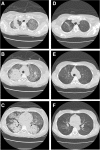Combined-modality therapy for pulmonary alveolar proteinosis in a remote setting: a case report
- PMID: 30866900
- PMCID: PMC6417025
- DOI: 10.1186/s12890-019-0822-x
Combined-modality therapy for pulmonary alveolar proteinosis in a remote setting: a case report
Abstract
Background: Pulmonary alveolar proteinosis (PAP) is a rare lung disease characterized by accumulation of phospholipoproteinaceous material in the alveoli. The presentation is nonspecific but typically includes dyspnea; the spectrum of disease includes rapidly progressive hypoxic respiratory failure. Whole lung lavage (WLL) is the treatment of choice in symptomatic PAP, but transient worsening of oxygenation sometimes requires salvage modalities of support such as extracorporeal membrane oxygenation (ECMO). Granulocyte macrophage colony-stimulating factor (GM-CSF) plays a role in the pathophysiology of PAP. We highlight a case of severe PAP treated with exogenous GM-CSF and sequential lobar lavage due to the unavailability of salvage methods of oxygenation.
Case presentation: A 36 year old female was admitted with fevers, chills, and progressive dyspnea. On presentation she was tachypneic, tachycardic, and hypoxemic; labs revealed leukocytosis and lactic acidosis. Chest CT identified diffuse ground glass opacities in a 'crazy-paving' pattern. Following intubation due to impending respiratory failure, bronchoscopy with bronchoalveolar lavage was performed. The lavage return stained positive with Periodic Acid Schiff, confirming the diagnosis of PAP. Continued deterioration necessitated treatment; however, at this geographically remote center without ECMO services WLL was judged to carry significant risk. Nebulized GM-CSF was administered without significant improvement. Subcutaneous GM-CSF was administered and isolated subsegmental lavages of the bilateral upper lobes were performed, with rapid improvement in oxygenation. Additional sequential lobar lavage and continued GM-CSF therapy as an outpatient resulted in complete resolution of oxygen requirement and return to normal pulmonary physiology.
Conclusions: The autoimmune form of PAP is the most common, indicating that therapy with GM-CSF may play an important role for many patients. Treatment with WLL may be impractical in some clinical settings due to the expertise and salvage modalities required. Sequential lobar lavage requires less specialized expertise and may incur less risk of refractory hypoxemia. We posit that this combined-modality therapy is ideally suited to geographically-remote centers such as our own.
Keywords: Granulocyte macrophage colony-stimulating factor; Pulmonary alveolar proteinosis; Whole lung lavage.
Conflict of interest statement
Author’s information
All authors were affiliated with Tripler Army Medical Center at the time of the patient encounters described. The views expressed in this paper are those of the authors and do not reflect the official policy of the Department of the Army, Department of Defense, or the US Government.
Ethics approval and consent to participate
Not applicable.
Consent for publication
Written consent was obtained from the patient for publication of this case report.
Competing interests
The authors declare that they have no competing interests.
Publisher’s Note
Springer Nature remains neutral with regard to jurisdictional claims in published maps and institutional affiliations.
Figures



Similar articles
-
A combination therapy of whole lung lavage and GM-CSF inhalation in pulmonary alveolar proteinosis.Pediatr Pulmonol. 2008 Aug;43(8):828-30. doi: 10.1002/ppul.20856. Pediatr Pulmonol. 2008. PMID: 18618617
-
Pulmonary alveolar proteinosis.Semin Respir Crit Care Med. 2012 Oct;33(5):498-508. doi: 10.1055/s-0032-1325160. Epub 2012 Sep 21. Semin Respir Crit Care Med. 2012. PMID: 23001804
-
Pulmonary alveolar proteinosis: an overview for internists and hospital physicians.Hosp Pract (1995). 2010 Feb;38(1):43-9. doi: 10.3810/hp.2010.02.277. Hosp Pract (1995). 2010. PMID: 20469623 Review.
-
Whole lung lavage combined with Granulocyte-macrophage colony stimulating factor inhalation for an adult case of refractory pulmonary alveolar proteinosis.BMC Pulm Med. 2014 May 19;14:87. doi: 10.1186/1471-2466-14-87. BMC Pulm Med. 2014. PMID: 24886114 Free PMC article.
-
Pulmonary alveolar proteinosis.Respir Care. 2011 Jul;56(7):1016-28. doi: 10.4187/respcare.01125. Epub 2011 Apr 15. Respir Care. 2011. PMID: 21496372 Review.
Cited by
-
How We Do It: Whole Lung Lavage.Sarcoidosis Vasc Diffuse Lung Dis. 2022;39(2):e2022017. doi: 10.36141/svdld.v39i2.12884. Epub 2022 Jun 29. Sarcoidosis Vasc Diffuse Lung Dis. 2022. PMID: 36118542 Free PMC article.
References
Publication types
MeSH terms
Substances
LinkOut - more resources
Full Text Sources
Medical
Research Materials

